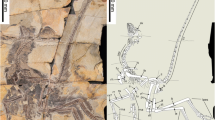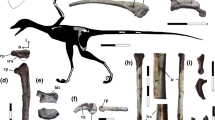Abstract
The unusual presence of long pennaceous feathers on the feet of basal dromaeosaurid dinosaurs has recently been presented as strong evidence in support of the arboreal–gliding hypothesis for the origin of bird flight, but it could be a unique feature of dromaeosaurids and thus irrelevant to the theropod–bird transition. Here, we report a new eumaniraptoran theropod from China, with avian affinities, which also has long pennaceous feathers on its feet. This suggests that such morphology might represent a primitive adaptation close to the theropod–bird transition. The long metatarsus feathers are likely primitive for Eumaniraptora and might have played an important role in the origin of avian flight.



Similar content being viewed by others
References
Beebe CW (1915) A tetrapteryx stage in the ancestry of birds. Zoologica 2:38–52
Burton JA (1973) Owls of the world. Dutton, New York
Chatterjee S (1997) The rise of birds. John Hopkins University Press, Baltimore, Md.
Chiappe LM, Ji S-A, Ji Q, Norell MA (1999) Anatomy and systematics of the Confuciusornithidae (Theropod: Aves) from the late Mesozoic of northeastern China. Bull Am Mus 242:1–89
Christiansen P, Bonde N (2004) Body plumage in Archaeopteryx: a review, and new evidence from the Berlin specimen. C R Palevol (in press)
Gao KQ, Shubin NH (2003) Earliest known crown-group salamanders. Nature 422:424–428
Hutt S, Naish D, Martill DM, Barker MJ, Newbery P (2001) A preliminary account of a new tyrannosauroid theropod from the Wessex Formation (Early Cretaceous) of southern England. Cretac Res 22:227–242
Jensen JA, Padian K (1989) Small pterosaurs and dinosaurs from the Uncompahgre fauna (Brushy Basin Member, Morrison Formation: ?Tithonian), Late Jurassic, western Colorado. J Paleontol 63:364–373
Ji Q, Yuan C (2002) Discoveries of two pterosaurs with fur-like integumentary structures and their stratigraphic significance. Geol Rev 48:221–224
Kirkland JI, Burge D, Gaston R (1993) A large dromaeosaur (Theropod) from the Lower Cretaceous of eastern Utah. Hunteria 2:2–16
Longrich N (2003) Archaeopteryx: two wings or four? J Vertebr Paleontol 3[Suppl]:72A
Norell MA, Makovicky P (1997) Important features of the dromaeosaur skeleton: information from a new specimen. Am Mus Novit 3215:1–28
Perez-Moreno BJ, Sanz L, Buscalioni A, Moratalla J, Ortega F, Rasskin-Gutman D (1994) A unique multitoothed ornithomimosaur dinosaur from the Lower Cretaceous of Spain. Nature 370:363–367
Ren D, Gao KQ, Guo ZG, Ji Q, Chen ZW, Yuan CX (2002) Stratigraphic division of the Jurassic in the Daohugou area, Ningcheng, Inner Mongolia. Geol Bull China 21:584–591
Shen YB, Chen PJ, Huang DY (2003) Age of the fossil conchostracans from Daohugou of Ningcheng, Inner Mongolia. J Stratigr 27:311–313
Wang XL, Wang YQ, Zhang FC, Zhang JY, Zhou ZH, Jin F, Hu YM, Gu G, Zhang HC (2000) Vertebrate biostratigraphy of the Lower Cretaceous Yixian Formation in Lingyuan, western Liaoning and neighboring sourthern Nei Mongol (inner Mongolia), China. Vertebr PalAsiat 38:95–100
Wang XL, Zhou HZ, Zhang FC, Xu X (2002) A nearly completely articulated rhamphorhynchoid pterosaur with exceptionally well-preserved wing membranes and “hairs” from inner Mongolia, northeast China. Chin Sci Bull 47:226–230
Wang Y (2000) A new salamander (Amphibia: Caudata) from the Early Cretaceous Jehol Biota. Vertebr PalAsiat 38:100–103
Weidensaul S (1995) Raptors-the birds of prey. Lyons & Burford, New York
Xu X (2002) Deinonychosaurian fossils from the Jehol Group of western Liaoning and the coelurosaurian evolution. PhD dissertation. Graduate School of the Chinese Academy of Sciences, Beijing
Xu X, Zhou ZH, Wang XL (2000) The smallest known non-avian theropod dinosaur. Nature 408:705–708
Xu X, Zhou ZH, Kuang XW, Wang XL, Zhang FC, Du XK (2003) Four-winged dinosaurs from China. Nature 421:335–340
Zhang FC, Zhou HZ, Xu X, Wang XL (2002) A juvenile coelurosaurian theropod from China indicates arboreal habits. Naturwissenschaften 89:394–398
Zhang JF (2002) Discovery of Daohugou Biota (Pre-Jehol Biota) with a discussion on its geological age. J Stratigr 26:173–177
Acknowledgements
We thank the anonymous reviewers for critical comments that have greatly improved the manuscript, Z. Y. Zhou, J. Clarke, P. J. Chen, Z. H. Zhou, X. L. Wang, F. Jin, Y. B. Shen, Q. Ji, D. Ren, W. Chen, and X. J. Ni for discussions and access to unpublished manuscripts and data, Y.-T. Li for preparing the specimens, R. -S. Li for drawings, Z. H. Zhou and X. L. Wang, among others, of the Liaoxi expedition team of the IVPP for fieldwork, Mark Norell for the help with NONA (version 2.0) software package and Joel Cracraft for bird specimens under his care. This work was supported by grants from the National Natural Science Foundation of China, the Special Funds for Major State Basic Research Projects of China, the National Geographic Society, the Chinese Academy of Sciences, and the American Museum of Natural History.
Author information
Authors and Affiliations
Corresponding author
Electronic Supplementary Material
Rights and permissions
About this article
Cite this article
Xu, X., Zhang, F. A new maniraptoran dinosaur from China with long feathers on the metatarsus. Naturwissenschaften 92, 173–177 (2005). https://doi.org/10.1007/s00114-004-0604-y
Received:
Accepted:
Published:
Issue Date:
DOI: https://doi.org/10.1007/s00114-004-0604-y




